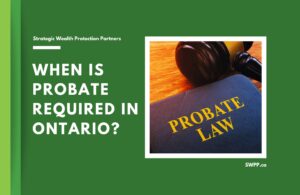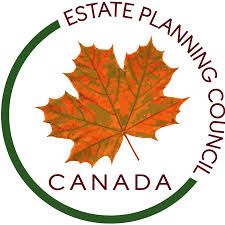In Canada, life insurance can be part of an estate, but it depends on who is named as the beneficiary.
If you name a specific person, such as a spouse or child, the life insurance payout goes directly to them and does not become part of your estate.
However, if you don’t name a beneficiary or if you name your estate as the beneficiary, the payout becomes part of your estate and may be subject to probate fees and claims from creditors.
Naming a beneficiary is the key to keeping life insurance outside of your estate.

Written by Ron Cooke, President & Founder of Strategic Wealth Protection Partners in Ontario, CEA®, Member of the Estate Planning Council Canada
Key Takeaways
- Life insurance can bypass probate when a beneficiary is named directly
- Policies paid to the estate can face taxes and delays
- Insurance can cover final taxes, debts, and create inheritance balance
- Permanent life insurance offers long-term value and flexibility
- Trusts can manage complex situations but aren’t always necessary
Is Life Insurance Part of an Estate After Death?
Most people misunderstand life insurance and underestimate how powerful it can be in estate planning.
Many assume it’s just a payout for surviving family, but in truth, it can be one of the most strategic tools to protect and transfer wealth. When a life insurance beneficiary is named directly on the policy, the insurance money bypasses the probate process, avoids delays, and is paid out tax free, without going through the estate.
This means the life insurance death benefit reaches your loved ones quickly, without being reduced by probate fees or caught up in legal proceedings.
However, if no beneficiary is named, or if the estate is named as beneficiary, the funds become part of the estate and are subject to probate, taxes, and potential creditor claims. That’s a detail many overlook until it’s too late.
More importantly, life insurance is the only way to transfer assets at full market value without the recipient paying income tax.
It offers immediate cash to cover estate costs like paying taxes on a registered retirement savings plan or capital gains on a family cottage, so your heirs don’t have to sell property or drain other assets to settle the estate. When planned properly, it becomes the cornerstone of a thoughtful estate strategy.
What Happens to Life Insurance After Death?
After the insured person dies, the insurance company must be contacted by the life insurance beneficiary or the executor.
They will ask for a copy of the death certificate, the completed claim forms, and possibly some supporting documentation. Once the claim is approved, the death benefit payout is typically released within 5 to 30 business days.
This process is much faster than settling the estate through probate, which can take months or even years.
Because of this, life insurance can provide immediate liquidity when it’s most needed for paying funeral costs, maintaining property, or paying taxes. The funds are not taxed as income to the recipient, and they are not subject to probate if a proper beneficiary designation was made.

Understanding Life Insurance and How It Works
At its core, life insurance is a contract with an insurance company that agrees to pay a lump sum, called the death benefit to your chosen life insurance beneficiary when you pass away.
You pay premiums to keep the coverage in force, and in return, your family receives a meaningful financial safety net when it’s needed most.
There are two primary types of life insurance: term insurance, which covers you for a specific number of years, and whole life insurance, which is permanent and lasts your entire lifetime. While term insurance is often used for temporary needs like income replacement or debt coverage, whole life insurance can play a much deeper role in long-term wealth planning and estate preservation.
Properly structured whole life insurance provides tax-deferred growth within the policy and allows for tax-free distributions through policy loans.
Over time, it can offer competitive returns with significantly less volatility than most market-based investments. Unlike RRSPs or TFSAs, whole life insurance can accommodate high contributions, making it especially useful for individuals looking to shelter more capital in a tax-efficient way.
Life insurance also offers no-loss provisions, meaning your accumulated value is protected from market downturns, and provides guaranteed loan options, allowing you to access funds when needed. The policy itself can even be used as collateral, unlocking liquidity without the need to liquidate other assets.
Perhaps most importantly, whole life insurance gives you control, over timing, over tax exposure, and over how your legacy is managed.
In estate planning, life insurance becomes a quiet but powerful tool to ensure that loved ones are not burdened with difficult financial decisions. It can be used to cover final expenses, pay taxes on a registered retirement savings plan, settle capital gains, or equalize inheritances between children. It’s not just about protection; it’s about precision, preparation, and preserving the legacy you’ve worked a lifetime to build.
For those looking to protect their legacy, life insurance is a tool that brings both peace of mind and financial clarity.
📖 Related Read: Is Life Insurance Worth It?
Types of Life Insurance and Their Benefits
There are two main types of life insurance in Canada: term life and permanent life insurance.
Term life insurance provides coverage for a fixed number of years usually 10, 20, or 30 and is often used to protect young families, mortgages, or income during working years. It is simple, affordable, and expires if you outlive the term.
Permanent insurance, which includes whole life and universal life, lasts for the insured’s lifetime and builds value inside the policy.
It offers long-term solutions for wealth preservation, tax-deferred growth, and estate planning.
Many Canadians use permanent insurance to fund future liabilities, such as paying taxes, covering debts, or leaving behind a life insurance death benefit to children or charities. It also provides options for liquidity, collateral access, and guaranteed payout regardless of when death occurs.
Who Needs Life Insurance and Why It Matters
Life insurance is essential for people who love someone, owe something, or own something.
It matters most for those with dependents, such as children or aging parents, for business owners with succession needs, and for high-net-worth individuals who want to preserve their legacy. If you have a spouse, partner, or family member who would be financially impacted by your passing, insurance provides the protection they need.
It is equally important for people who may not have significant debts but want to leave behind a death benefit payout to simplify their estate, settle final taxes, or create fairness among heirs.
Even retirees can benefit, particularly if they want to cover capital gains on a registered retirement savings plan or ensure the smooth transfer of a family property.

The Role of Beneficiaries and Probate
When a life insurance beneficiary is named directly on a policy, the insurance money bypasses the probate process, which means it is paid directly to the primary beneficiary without delays, legal costs, or creditor claims.
This avoids adding the death benefit to the estate and shields the funds from probate fees in Ontario.
However, if no beneficiary is named or if the policy names the estate as the recipient, the life insurance death benefit becomes part of the estate. In that case, the money is exposed to probate fees, potential estate taxes, and can be delayed in distribution.
Designating beneficiaries properly ensures that loved ones receive funds quickly and without unnecessary complications.
Estate Tax Implications of Life Insurance
In most cases, life insurance proceeds are not taxed when paid directly to a named beneficiary.
But if the insurance company pays the death benefit to the estate, it becomes part of the estate’s value, which can increase the tax exposure. The larger the estate, the more likely other taxes will apply especially capital gains on RRSPs, rental properties, and private business shares.
By setting up life insurance properly, it can act as a separate, tax-free stream of cash to pay those liabilities. Without this planning, families may be forced to sell cherished assets just to cover the tax liability triggered upon death.
Using Life Insurance Strategically in Estate Planning
Life insurance can be one of the most precise financial tools for estate planning.
It ensures that beneficiaries are not burdened by large final bills and helps you pass on assets without disruption.
You can use life insurance to:
- Cover capital gains taxes on properties or private company shares
- Provide cash to pay debts or equalize inheritances among multiple children
A financial advisor can help identify exactly how much insurance is needed and how best to structure ownership, especially for families with large estates or business assets.
Cover Taxes
Life insurance provides a tax-free cash injection to pay final income taxes on assets like RRSPs or rental properties, preventing forced sales.
Cover Debts
Insurance can ensure that mortgages, lines of credit, or private loans are paid off immediately, so your estate is not burdened or delayed.
Provide Liquidity
Insurance gives your heirs quick access to cash while the rest of the estate is going through probate, which can take months or longer.
Equalize Inheritance
If one child receives a property or business, life insurance can provide equal value to other children, keeping things fair and avoiding conflict.

Trusts as Beneficiaries of Life Insurance Policies
In certain cases, naming a trust as the life insurance beneficiary makes sense—especially when beneficiaries are minors, have disabilities, or need funds managed over time.
A trust can offer control, structure, and legal protection, allowing the death benefit payout to be distributed on your terms. It’s also useful when planning for complex family dynamics or blended families.
However, naming a trust may also create tax consequences or administrative complexity.
If the trust is not structured correctly or isn’t needed, it can reduce flexibility and increase cost.
For many families, naming individuals directly is simpler and more effective. The right choice depends on your estate goals, the needs of your beneficiaries, and how you want your legacy managed.
Common Questions about Life Insurance and Estate Planning
Does life insurance go to estate or beneficiary in Canada?
If a beneficiary is named, it goes directly to them and skips the estate. If no one is named, it goes to the estate.
What assets are not considered part of an estate in Canada?
Assets with named beneficiaries like life insurance, RRSPs, and TFSAs typically bypass the estate and avoid probate.
Is life insurance considered an asset in Canada?
Yes, but only if it is payable to the estate. When paid directly to a beneficiary, it is not included in the estate’s value.
Is life insurance paid to an estate taxable in Canada?
It is not subject to income tax, but it becomes part of the estate and may increase probate and tax exposure.
Should I include life insurance in my estate plan?
Absolutely. It plays a critical role in funding taxes, settling debts, and transferring wealth smoothly and efficiently.
Does life insurance have to be used to pay the deceased’s debts?
Not if it is paid to a named beneficiary. If it goes to the estate, it may be used to pay creditors before heirs receive funds.
What forms part of an estate?
All assets owned in the deceased’s name alone—real estate, investments, personal property, and insurance without a named beneficiary.
What is an irrevocable life insurance trust?
It is a legal structure that owns the insurance policy and controls the death benefit, often used to protect wealth or manage taxes.
Is there such a thing as a bad life insurance policy?
The wrong type of policy for your needs can be costly or ineffective. Good insurance solves the right problem at the right time.
Final Thoughts
According to a 2023 study on life insurance in Canada, 31 percent of Canadians say they need or need more life insurance coverage.
But while some Canadians wish to purchase more life insurance, they may not know how their insurance fits into an estate plan. In addition, for Canadians with substantial assets, it’s important to have the right type of life insurance and structures in place to prevent excess taxation upon death.
While there’s no such thing as bad insurance, you do want to make sure you have the right insurance for the problem that you’re aiming to solve.
If you have investable assets north of three million dollars, then it’s critical that you work with an estate planning expert who can help ensure that your estate doesn’t get taxed excessively upon death.
The greater your assets, the more opportunities you have to use life insurance and other tax strategies to build wealth while also protecting your legacy.
Discover How to Minimize Taxes and Secure Your Legacy
Did you know that without a solid estate plan, taxes and fees in Ontario could claim a significant portion of your wealth?
If you’ve worked hard to build your business, investments, and properties, protecting your legacy for your loved ones is critical. At Strategic Wealth Protection Partners, we specialize in helping high-net-worth individuals in Ontario secure their financial futures.
Our Living Estate Plan is designed to:
- Reduce estate taxes and probate fees.
- Simplify wealth transfer to your loved ones.
- Reflect your values and priorities in every detail.
Your Legacy Matters
With our personalized guidance, we’ll help you navigate options like Living Trusts to protect your assets and ensure your family’s peace of mind. Contact us today to book your Living Estate Plan Consultation and take the first step toward a secure future.
Schedule a Living Estate Plan Consultation
Planning your legacy is about more than numbers—it’s about ensuring your family remembers you and your values are honoured for many years to come.
Estate planning and trusts can feel overwhelming, especially if it’s your first time. That’s why we’re here.
With our simple, 5-Step Living Estate Plan, we make the process easy, helping you create a comprehensive estate plan or trust that protects your assets from taxes and probate fees while preserving your legacy. Tools like The Final Word Journal capture your story, wishes, and essential details like accounts and end-of-life plans, ensuring your family has clarity and comfort.
Take the first step today—schedule a consultation call and give your family the ultimate gift: peace of mind and the assurance they were always your priority.
Read More
If you’re starting your estate planning process, you may find these articles helpful:
- What Is Death Tax in Canada?
- Does Canada Have a Death Tax?
- Is Life Insurance Worth It in Canada? Pros & Cons
- Is Life Insurance Taxable in Canada?
About the Author
RON COOKE, PRESIDENT & FOUNDER OF STRATEGIC WEALTH PROTECTION PARTNERS

With over 30 years in financial services, I’ve seen the challenges families face when a loved one passes—lost assets, unnecessary taxes, and emotional stress. That’s why I created the Living Estate Plan, a comprehensive process to protect assets, eliminate estate and probate fees, and create legacies that are remembered for many years to come.
This plan ensures your family receives not just your wealth, but a meaningful reminder of your care and love. Tools like The Final Word Journal capture your story, wishes, and essential details, offering clarity and comfort during difficult times.
Your final gift should be more than money—it should be peace of mind, cherished memories, and an organized estate.
Schedule a Call
Schedule a 30-minute consultation call with Strategic Wealth Protection Partners.
Click HERE to schedule a consultation.









